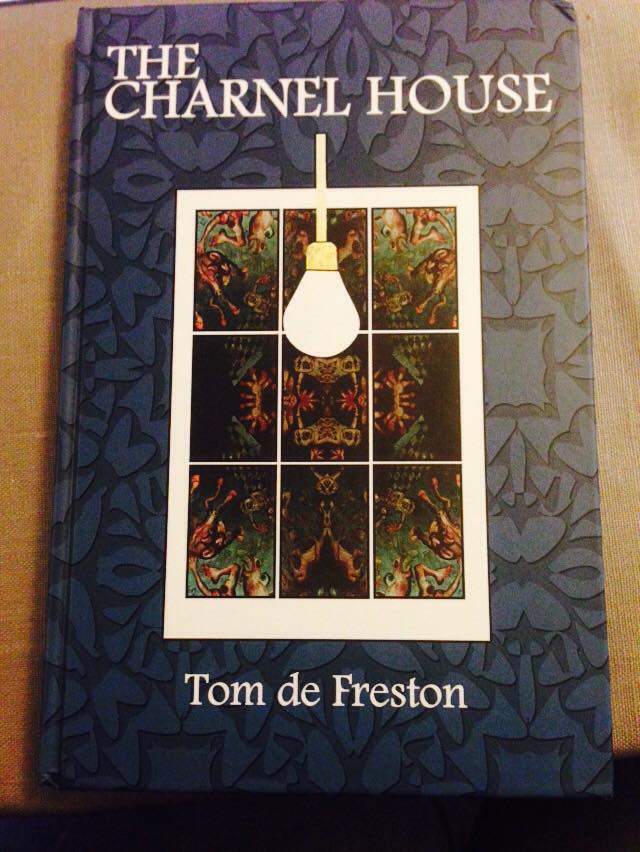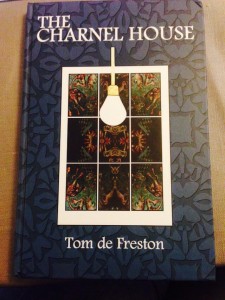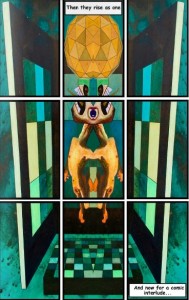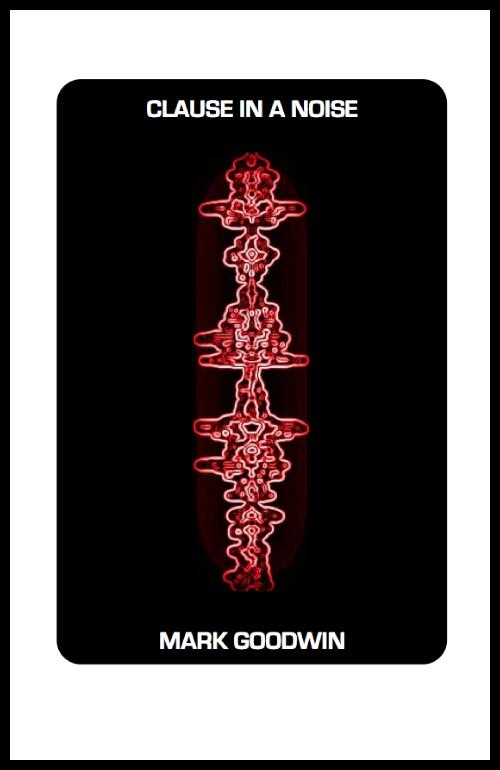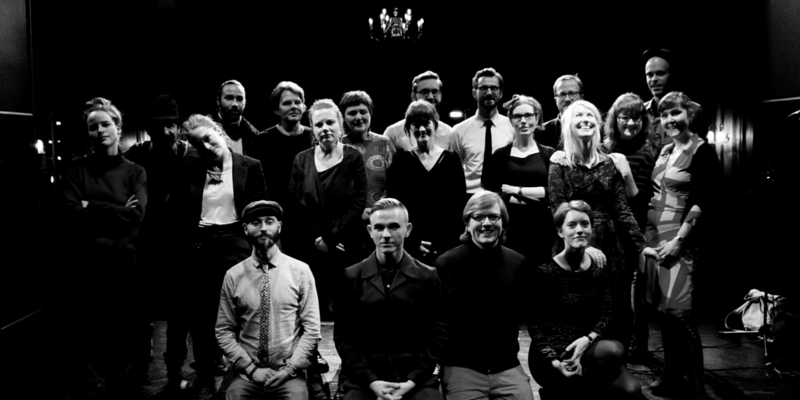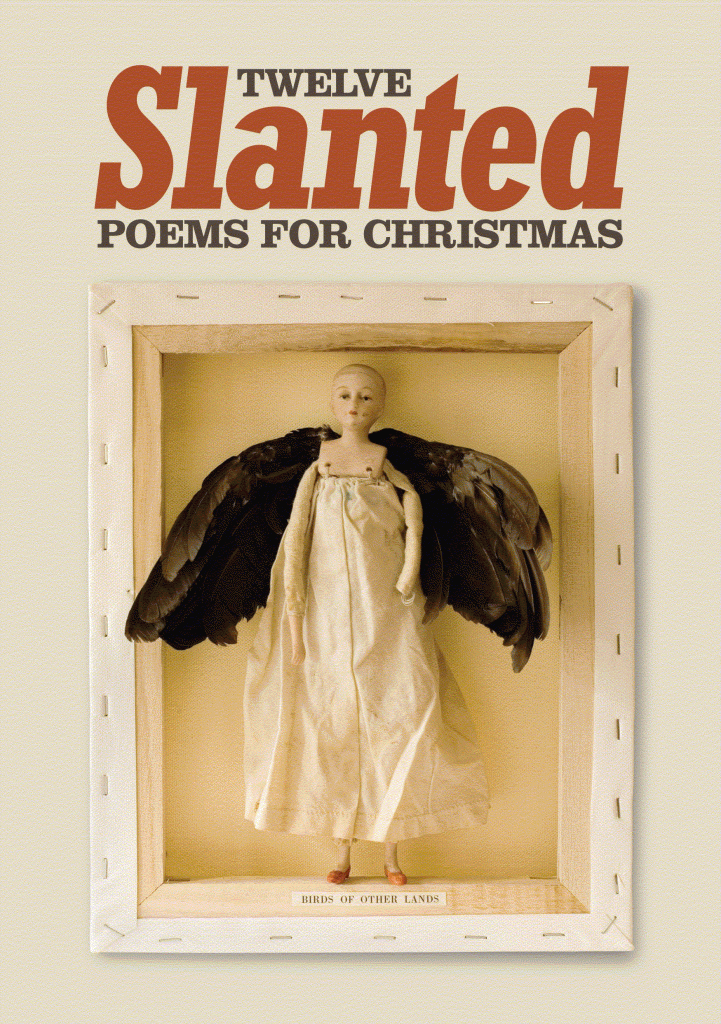The Charnel House by Tom de Freston et al.
-Reviewed by Hayden Westfield-Bell–
The Charnel House is difficult to describe; Freston himself categorises it as a kind of ‘poetic graphic novel’, but I would argue that this description is too limiting – the ‘novel’ resists traditional reading methods, produces and challenges internal textual and illustrative relationships, and places a heavy emphasis on tone and atmosphere. It’s a very experimental and incredibly powerful anthology of poems and illustrations that probe the relationship between mind and body, reality and dreamscape, passion, lust, love, symmetry and the uncanny (unheimlich). Now, if this all sounds a little heavy don’t worry; despite some heady themes the anthology remains easily accessible to the casual poetry reader, and I’d strongly recommend grabbing a copy. It’s deep, dark, emotional stuff.
I want to begin with a short paragraph about the history of the project, because the way in which the materials have been collated is helpful in gaining an understanding of the general feel of the collection. Freston writes that the horsehead protagonist which is the focus of ‘The Charnel House’ emerged in 2008 when he was creating animal-human hybrids for a play. The character reemerged in Freston’s later work, during which he recognised that the character was ‘in need of an entire world and narrative’. Having a keen interest in ekphrasis, Freston sent images of his work to poets he admired and asked them ‘to respond to one of the horsehead paintings, with ‘no limitation beyond being asked to avoid descriptive ekphrasis and being encouraged to use the paintings as a start point rather than a restraint’. After receiving the poems, Freston felt that simply placing the poems and illustrations together on the page wasn’t enough, and so the concept of the ‘poetic graphic novel’ was born.
And it works, it works surprisingly well. I think this has a lot to do both with Freston’s art style, and with his specific instructions regarding how to respond to his pieces. The illustrations are sharp, surreal and harsh; violent domestic environments viewed from uncomfortably tight corners, or dark Jungian dreamscapes smeared with the suggestion of hope; bright pricks of colour shooting across the canvas – catching the eyes of the fleshy mutated figures bent double below. I was deeply unsettled by Freston’s images, yet I kept coming back to them – curious to understand the meaning behind their symmetries, or to seek further clarification on the mysterious narrative that binds the two forms together. The plot is vague, but Freston does a good job of reinforcing themes and events by adding text and motion to his pieces, even inserting lines from the adjoining poem into the image for emphasis.
The contributing poets have really captured the Freston’s style and the essence of their chosen image which has resulted in a curiously coherent collection; the bleak, almost dystopian imagery is present in all of the poems and helps to create this feeling of wholeness, and is explored variously and vigorously – through tone, imagery, vocabulary, gesture, mood et al. And there are some incredibly powerful poems in the collection…. the final lines of Samir Guglani’s ‘A Wedding Horse’ have stuck with me these last few days:
You draw close again, become breath
held at my mouth. Past you, further out,
cars recede up an erased hill,
rising slowly through the dust, like fireflies.
and Kaddy Benyon’s ‘Fool’s Gold’ presents itself as a full wall of words cascading down the page, the rhythm pulling the reader through what seems initially to be an impenetrable barrier of text:
Yet I’m wedded
merely to impotence – shrunk to the nothing
of a blind writhing bairn frantic to scratch
at the lustrous face of its distant/present
mother, the full-milked white of her,
Lydia Macpherson reimagines a blood-red image of a twisted dance featuring horse-headed characters as ‘it all kicked off: the rush / of hooves, pelts of envy, heaving sickness, / hate’ and Jenny Lewis describes a questionably human fleshy mass as; ‘a flower of muscle / peeled from the entry point.’ But not all is miserable and malformed; a key theme of the collection is identity, and the complexity of the self. During the narrative the protagonist undergoes a strange metamorphosis and is rendered horse-headed, but though he has altered externally he is still he, and so must struggle with his new physical appearance. So, for instance, in ‘Mules Revisited’, Helen Mort finds cause to celebrate this struggle; ‘Don’t ask us / how we fell // but how we rose’, how ‘pit children / slick with earth, we / shrugged the ground off’.
Pascale Petit, George Szirtes, Helen Mort, Abegail Morley – all penned poems for the collection, alongside a number of others. In fact, there are a total of 37 poets in the anthology and the publication is over 120 pages in length! There is a little filler towards the centre of the book; a ‘comic interlude’ featuring a couple of poems and illustrations that – though smile inducing, and a welcome break from the intensity of the narrative – feels a little awkward given the nature of the content shown so far. I also think that the inclusion of some of the lines over the illustrations is, in places, a little too telling; I really enjoyed piecing together which poem responded to which piece, which often took a lot of studying. The embedded lines detracted from this experience sometimes, as I quickly knew which poem and image was connected. Also, I feel that Freston’s words are often more than enough, and his narration becomes a stable voice for the text – which the lines from the poems upset when placed in the image. It’s a small complaint, however, given how much I enjoyed reading and re-reading it!
Poetry is constantly changing. There are hundreds of poets out there right now, sharpening their lines, perfecting their rhythms and experimenting with structures new and old, but like all art forms some movements within the form gain traction more than others. The last few months, through engaging with poetry in pubs, on the streets, through publications and on the internet, I’ve noticed a growing popularity for delicate poesy – for intimacy, clarity, and scientific sharpness. These poems tend to focus on romantic relationships, sexual relationships, or relationships with the world around us: urban, natural, suburban. What I enjoyed most about ‘The Charnel House’ is that it stepped away from that. Yes, it’s incredibly delicate in places… but there’s so much power too; Freston and the contributing poets sink the knife in deep, twist, and keeps twisting. It’s so intense, so dark, so emotional, surreal, yet deeply internal, even personal. It’s a tough collection to get through, I’ll admit that, but its content is so rich, and the poems and illustrations so moving that you’ll find it hard to put down once you’ve started. It’s an incredible collection.
The Charnel House is available as a free e-book and as a hardback published by Bridgedoor Press.

